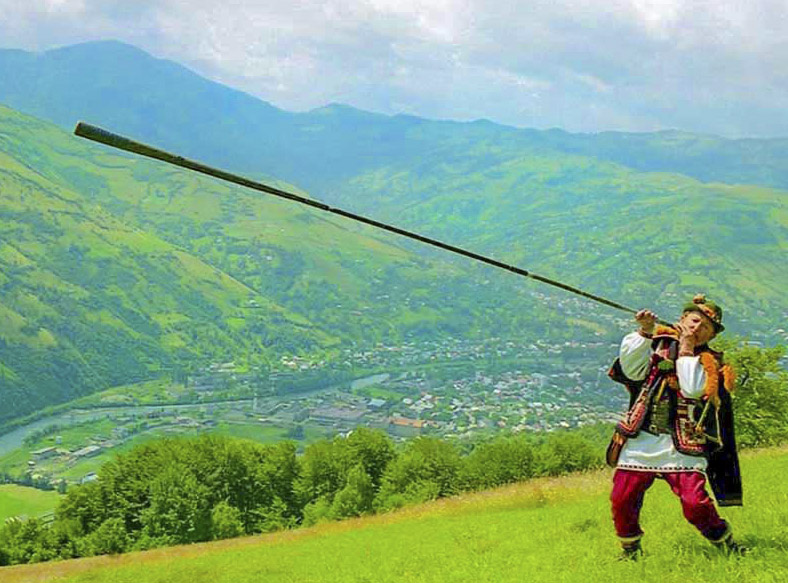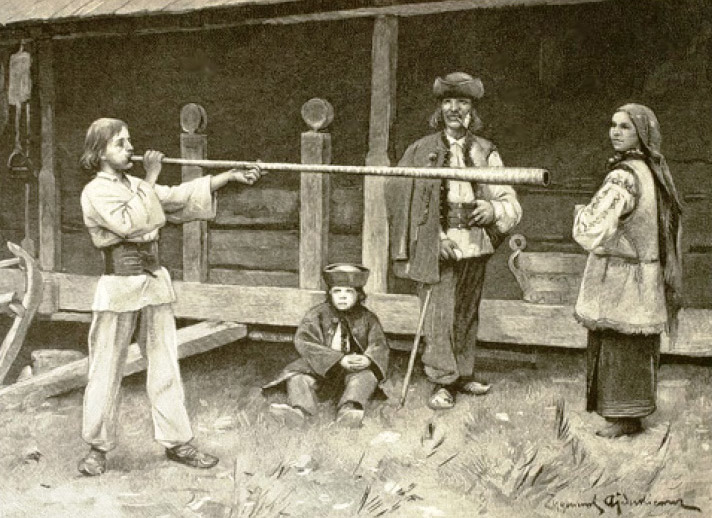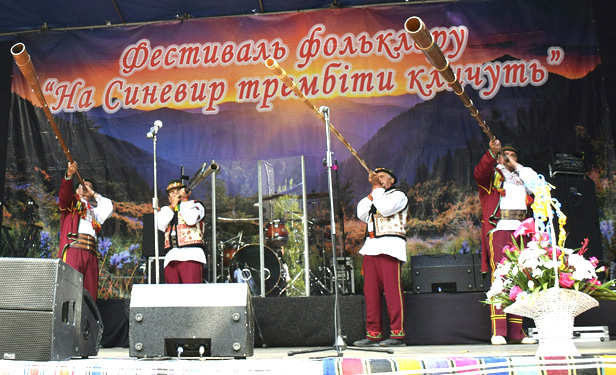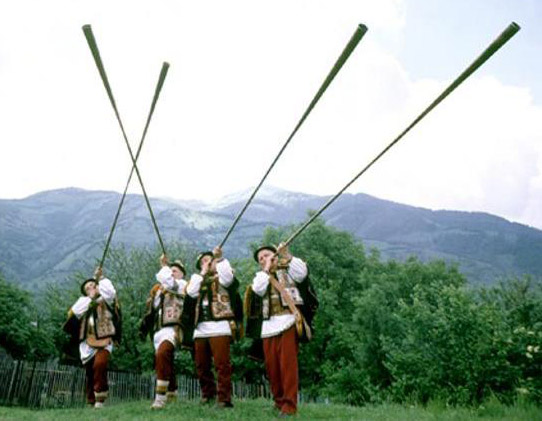Photo. Trembitari // https://koruna.ua/articles/trembita-zagadkovyj-magichnyj-instrument-gutsuliv/
The trembita is the traditional Ukrainian musical wind instrument. The Motherland of trembitas is the eastern part of the Ukrainian Carpathians. The trembita as a musical instrument is associated mostly with the Hutsul’s culture. But there are evidences that the Boikos also employed trembitas. However, trembitas of the Boiko’s differ in design from the Hutsul’s ones. Also, this musical instrument was applied by the Lemkos and other local ethnographic groups.
The name of trembita probably originates from Proto-Slavic word “trǫbica” (“trǫba”) with the meaning of ‘tube’, as its design implies. To play the trembita is to trembitaty, while a person who plays it is potrembach or trembitar.
The trembita was served not only as a musical instrument, but initially it was mostly used as a signal article. For quite a long time, the trembita was the only connection device between the chaban (the shepherd) and the world around. Trembitas were used instead of clocks: the precise hour was determined by the length of its shadow. The signals were given with them on the beginning and the end of the working day, sheep milking and lunch for shepherds and sheep breeders. They developed the integral system of the sound tones. By these sounds, the people in the villages and on the mountain pastures could learn where the shepherds with their flocks were. In the spring, when the shepherds were driving their flocks to the mountain pastures, the first flowers were in blossom, they were listening to the cuckoo bird voice and the first breeze of the warm weather, the trembita’s song was cheerful. In autumn, on the contrary, its song was dull and dreary, as the cold winds were blowing, the sky was grey, the birds flew to the warm climates and the shepherds had to drive the flocks into warm sheepfolds.
The trembita also gave the signals of alarm which the watchers on the tops of the mountains passed to one another informing from what side and where the invaders were moving. The trembita served as a conductor for the lost travellers.
The length of this instrument is from 2.5 m to 8 m, therefore its sounds are heard far away: the longer the instrument, the farther its sound goes. The good trembita is considered to be not shorter than 3 m, the conventional length is 3.2 m and its voice can be heard tens kilometers away. People say, that the sounds of the longest trembitas could be heard at the distance of 50 kilometres.
The trembita accompanied all the Hutsul fests and rituals: neither celebration nor important event could occur without its song. Via the trembita, the local people could learn about the birth of a new baby, could be invited to the wedding, could be informed about the funerals and even Christmas celebration rituals. Nowadays, these old musical instruments are used by artists and are ethnographic objects.

When the trembita appeared in Ukraine is not known precisely. Old people tell from what they heard from their ancestors that at the times as old as the mountains, the Rusyns were escaping from by conquering nomads and found the shelter in the Carpathians. People say, the evil reigned at those times, everyone was bothered how to survive. They settled by families. Some of them decided to live farther from the settlements.
The family where handsome lad Ivasko was growing into manhood went to the Beskid Mountains, while the family where lived Marichka, a maiden, slender as a spruce and tender as a flower, travelled to reside to the Mount Hoverla. The families separated and they separated the lad (legin) and the maiden (junka). Missing his beloved, Ivasko created two nice trembitas, one with the strong voice as the thunder – for himself and the other was sonorous as her laughter – for Marichka. His call from the Beskid Mountains was heard by the girl at the Mount Hoverla. They developed their language of trembitas. But the destiny did not allow them to be together. Ivasko was killed when fighting with a predatory beast. The girl did not know about it and was calling, calling, calling… Once she took her trembita and ascended Hoverla. The girl had never been seen anywhere since that time. But when somebody’s beloved died in the Carpathians, the trembita’s song full of sorrow was casting from Hoverla …
This legend full of romance and sadness still lives in the Carpathians. But there is the other one. At very old times, there were three Hutsul brothers who inherited a large sheep flock. They were not experienced shepherds at all because they were very young and lost many of their sheep on the first day. Being in despair, they came for a good advice to a wise elderly man. The elderly man found the fir-tree in the forest and made a marvelous musical instrument of it, its voice was heard all over the mountain valley. Since that time the musical instrument with the voice of a real thunder has been sounding in Hutsul’s land, helping both the shepherds and the lost travellers.
The trembita manufacturing is a long and complex practice, inextricable with the number of beliefs, rituals and even superstitions. Traditionally, the trembita is made from hromovystia – a tree once struck with a lightening. The thunderbolt splits the tree into even parts better that the carpenter could do it. The trembita produced in such away sounds better. Moreover, it will drive the evil spirits away from the sheep flocks and the shepherds, according to the beliefs. However, if you cannot procure such a tree, you can take any other with a long and straight trunk. The age of the tree should be 120-150 years old. The way how you prepare the wood for the trembita is a very important issue: the more it withstands under the sun, rains, snows and winds, the louder will be its sound. Sometimes its holding takes several years. Also the wood for the trembita is soaked in the water of mountain rivers for acquiring the voice resembling the spring streams.

To split the tree trunk into the two, the craftsman dips the blade of the Hutsul hatchet into the wood 10 –15 cm deep and then by pressing he obtains two parts. If he does not manage to do it, all the efforts will be in vain – the tree trunk will be discarded. That part of the wood which has been touched by metal is cut off. Then, the blanks which are two equal parts now are hollowed out in order to remove the core completely and leave only the outer shell of 2 mm think. For uniting the two parts, they do not employ any glue but only hoops of spruce boughs or birch bark. The final stage is making a mouthpiece. It could take from 1 or 2 years up to several ones to produce one trembita. The weight of it is around 1.5 kg.
Nowadays, there are no many craftsmen who are able to produce such a magnificent instrument by the traditional techniques only. The Hutsul trembita is a rare and expensive instrument. The antique instruments are now exhibited in the museums, the private collections or are kept as family relics. There is no plenty of those who can play the trembita. Those who are skilled in it are mainly the elderly men, they were taught to play the trembita in their childhood or youth. Some of them learned this art by themselves as Vasyl Yaniuk, some were taught by their grandfathers or fathers as Ivan Kokish (both musicians are from Rakhivshchyna). The brothers of Ivan Kokish also play the trembita, his grandson is studying this art. Ivan Kokish is teaching the several boys how to play it. But he does not want to teach his granddaughters as this instrument is conventionally considered not for women. It is physically difficult to play the trembita, as the musician (trembitar) should possess strong lungs and skillfully direct the stream of air which he introduces into the trembita.
Trembitars are still invited to the various villages to play at weddings or to note about the funerals. But more often they display their skills at local art fests or festivals. For instance, trembitar Vasyl Sopko is famous in the all Zakarpattia region as he constantly takes part in the festival, called Trembita Call You to Synevyr.
This festival has been held since 2002. The highlanders celebrate this fest of the folk music on the picturesque mountain lake of Synevyr. The best folk instrument players are called for the festival, but everyone who has a burning desire can enjoy the opportunity to play the trembita being taught by an experienced trembitar.

The trembita is listed in the the Guinness World Records as the longest musical instrument in the world. In 2019, the musicians set the All-Ukrainian record by playing together the 146 musical instruments of trembitas and Hutsul horns in Ivan-Frankivsk.
The tourists who travel throughout Zakarpattia adore buying trembitas along with the other souvenirs. In Kosiv, the historical site of Ivano-Frankivshchyna, trembitas are sold at the fair. The craftsmen eagerly tell about the specific character of their manufacture and allow the tourists to play their trembitas.
The trembita is the soul of Hutsulshchyna, the part of the cultural and spiritual heritage of the whole Ukraine.
Див. статтю "Трембіта – таємнича душа Карпат"
Our Advice to Read:
Яремко Б. Трембіта як пам'ятка духовної культури гуцулів // Київ: Проблеми етномузикології, 2009.– Випуск 4.– С. 260—268. http://www.nbuv.gov.ua/old_jrn/Soc_Gum/Petnomuz/2009_4/017.pdf
We also advise you to watch:











